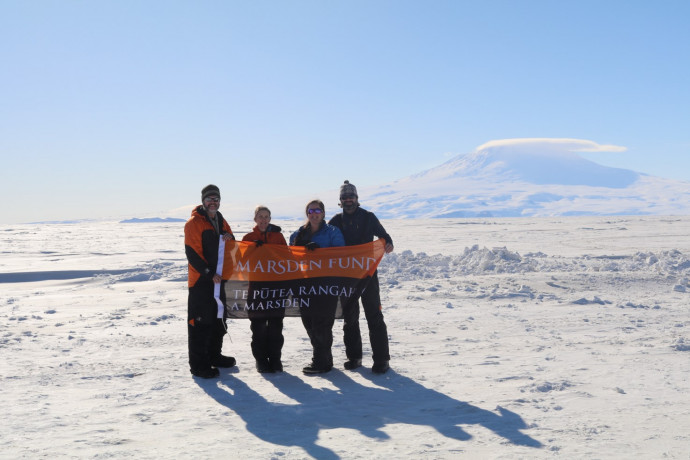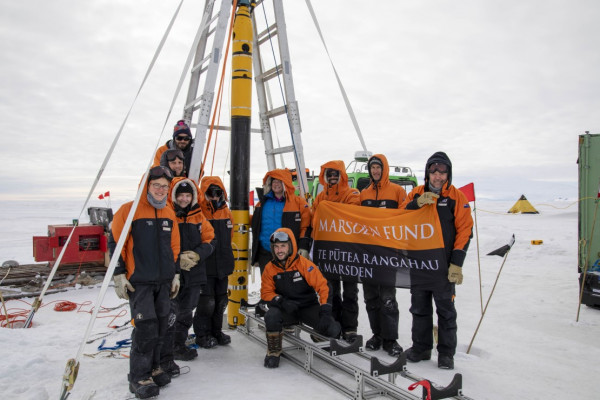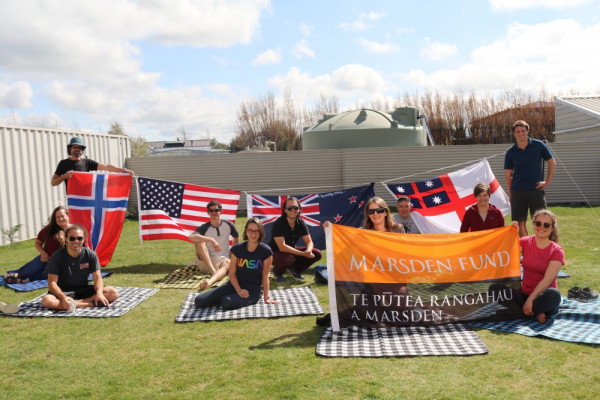Research
Published 19 January 2022The "supercoolest" science on Earth

A team of Antarctic scientists is breaking new ground – or ice at least – in scientific research
They’ve designed a cutting-edge device to measure supercooled ocean water under sea ice.
The Kiwi-led project, funded by the Marsden Fund, is collaborating with Norwegian and US scientists to build a High Precision Supercooling Measurement Instrument (HiPSMI) that can be sent below the ice on the Icefin (a small, remotely-operated submersible robot) to precisely measure exactly how cold the water gets.

Group photo with HiPSMI onboard Icefin. (L-R front): Maren Richter (UOO, PhD student), Dr Enrica Quartini (Cornell), Dr Inga Smith (UOO), Associate Professor Britney Schmidt (Cornell), Dan Dichek (Georgia Tech, kneeling), Professor Lars Smedsrud (Bergen), Brett Grant (NIWA), Dr Pete Russell (UOO). (L-R back): Dr Andy Mullen (Georgia Tech), Ben Hurwitz (Georgia Tech). Photo credit: Dan Dichek
Dr Inga Smith, from the University of Otago, says sea ice usually freezes at -1.9 degrees Celsius. But that’s not the case when fresh water flows from beneath an ice shelf and mixes with the salty sea water.
“Then it becomes what’s called supercooled, so it’s still liquid but actually below the freezing point. It then snap freezes into these crystals called frazil, they attach to the sea ice and form platelet ice. That means the sea ice in this area is thicker and grows faster than it would otherwise, certainly thicker and faster than you would expect in the Arctic, for example, in a similar location.
“We’re really pushing the edge of polar engineering here, operating in these really cold temperatures and making high-precision measurements of that supercooling,” she says.
Maren Richter, a PhD student from University of Otago, says oceans under ice shelves are a large black spot in our knowledge.
“We know more about the dark side of the moon than we know about what’s going on underneath the Ross Ice Shelf!
“These measurements help to inform understanding of how the system that is the ocean, the ice and the atmosphere works together, and how that all interconnects. These are all calculated by large scale models and the more accurate we can make these models, even on really small scales like this, the more accurate it will be on larger scales like informing weather in the future in New Zealand,” she says.
To test the HiPSMI in Antarctica for the first time, the team worked out of a containerised ice camp on McMurdo Sound. Sarah Williamson, Antarctica New Zealand Chief Executive, says the containerised camp, owned by NIWA, was key for the team’s success.
“They managed to collect oceanographic and sea ice data for 17 of the 20 days at the ice camp, and HiPSMI data on eight of those days. It’s always satisfying when we can support this world-leading science so successfully in Antarctica, particularly when it has such important ramifications for the rest of the planet,” she says.

Group photo at the Methven pre-Antarctic isolation facility, 10 October 2021 (after everyone had cleared all their COVID-19 tests).(L-R front): Ben Hurwitz,(Georgia Tech), Frances Bryson (Georgia Tech), Dr Inga Smith (UOO), Maren Richter (UOO). (L-R, second row): Associate Professor Britney Schmidt (Cornell), Brett Grant (NIWA), Dan Dichek (Georgia Tech), Dr Pete Russell (UOO), Dr Enrica Quartini (Cornell), Dr Andy Mullen (Georgia Tech). (Standing with Norwegian flag) Professor Lars Smedsrud (Bergen). Credit: Nicky Burgess
Additional:Additional information: Newshub interview, 'Kiwi-led Antarctic HiPSMI project hoped to help with climate change understanding'
Additional information: Radio New Zealand interview with Inga Smith, 'Scientists send machine under Antarctic ice shelf'
RESEARCHER
Principal Investigator: Dr Inga Smith (University of Otago). Associate Investigators: Dr Greg Leonard (University of Otago), Associate Professor Britney Schmidt (Cornell University), Dr Lars Smedsrud (University of Bergen)
FUNDING SUPPORT
Marsden Fund
CONTRACT OR PROJECT ID
UOO1825
